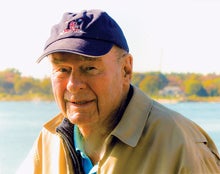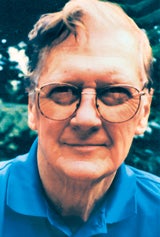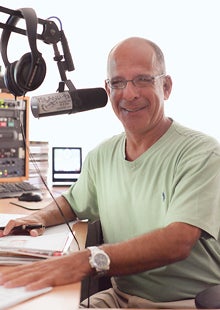Feedback
 The Fast Break
The Fast Break
Basketball three-quarters of a century ago, before URI evolved from Rhode Island State College, remains an important part of the URI’s history worth retelling, especially for recent grads not aware of its significance.
My story begins with Marshall Tyler, called “Tip” for a presidential Tyler. He came to Kingston in 1898 from Amherst, and made math so rigorous the school soon became noted for engineering—but there had to be sports, so he coached them all. He saw the forlorn kid in me, whose father died due to strains of the Depression and injuries sustained in WWI. My own grandfathers never had a word for me, but my step grandfather, Professor Tyler, while managing a family of five children, sent me a Christmas present, The Romance of Astronomy, one of the last books I’d ever part with.
The coaching became too much, so he brought from a high school in Massachusetts the soon-to-be-legendary basketball coach Frank Keaney. Keaney became impatient with the game’s slow pace, especially the jump ball after every basket. So he all but invented the fast break, not caring if the opposition made 100 points, just so his team scored 102. Faster and still faster Keaney encouraged his players, as their speed and conditioning soon outpaced rivals.
Practices were held in the ancient Rodman Hall. One basket was two feet from a wall, the opposite basket at the building’s entrance. Practices in this echo chamber became after-class recreation for students, with Keaney strutting around in baggy gray warm-ups, exhorting his team to go ever faster and “keep your eyes off the coeds in the balcony.”
One intrasquad practice I remember most clearly: A guard jumped and grabbed the ball as it fell through the net, twisted in midair, placed a foot on the wall and sprung off, riffling a pass to a teammate racing for all he was worth down court, so fast he missed the pass, went through the entrance and down the steps. Keaney’s classic remark summarizes everything: “Ok, next time faster.”
During WWII, when male students numbered about 50, Keaney grabbed anyone over 5-foot-10 and put him in a uniform. Later came the National Invitational Tournament in Madison Square Garden. To get his players acclimated to the smoke-filled Garden, Keaney lit smoke pots in the gym. Always going one better than the opposition, he turned to chemistry again and developed a light blue color for uniforms that proclaimed: here were boys playing against the likes of New Yorkers in their shiny rayon outfits, with their boring mid-court weaves.
Those wonderful days of innocence: boys in light blue uniforms, Keaney cavorting—somehow the game lifted my spirits to grow and do something exciting.
—Perry Jeffries ’51, M.S. ’55, Professor Emeritus of Oceanography
West Kingston, R.I.
 Typewriter Tale
Typewriter Tale
At the end of my sophomore year at URI, the Providence Journal hired me as its campus correspondent. I would be paid 10 cents per published inch (minus headlines), which meant I could earn $10 per week, if I hustled. My impending career as a part-time journalist, however, was somewhat in doubt because I couldn’t type. So that summer, I found my aunt’s typewriter, which had been sitting, uncovered, on a shelf for years, collecting dust and grime. I cleaned it up and spent one hour every weekday that summer typing exercises from a high school manual.
Before starting my job I visited the Journal’s local news bureau, where I met the manager. He said, “You’re not just a reporter now, you’re also a photographer.” He handed me a manual on how to use the Speed Graphic, an unwieldy, heavy camera.
I liked the idea of taking photographs, because they earned me $5 each. Most beloved photographs, I learned, featured dogs, cute children, or lovely young ladies. The campus had its share of the latter, including my wife to be.
The camera produced other benefits. As a sometime writer for the campus newspaper, I had access to a campus darkroom.
So I started taking group pictures of fraternity and sorority members. Individual prints went for $1 each.
In the fall, after two years as a chemistry major, I had a moment of doubt in the chem lab, while trying to weigh a sample in hundredths of a gram. It was not what I wanted to do for the rest of my life, so I changed course and became an English major with minors in political science and history.
In the summer between my junior and senior years, the Journal asked me to become a “vacation relief reporter.” So I roamed around Rhode Island and southern Massachusetts in a 1934 Ford, which I bought for $150. I went to a lot of clambakes, where listening to politicians was mandatory.
My first stop in my Journal circuit was North Providence, R.I., where my office was in a corner at the back of a drugstore. My desk was an old booth, and I was advised to have a lot of change so I could use the pay phone on the wall. At the end of the summer, the paper had its own clambake for the staff, and I got talking to a man I did not know. He asked me what I wanted to do when I graduated. I said I wanted to get a master’s degree in journalism from Columbia University. Shortly thereafter I learned that I had been talking to the publisher of the Journal—and that he was on an advisory committee at Columbia. I got in, joining a class of 85, which included a priest, Isaac Asimov’s brother, a former Israeli soldier, and students from across the U.S. and several foreign countries.
Money was tight at Columbia. There was no scholarship help and I was dependent upon the money I had earned in the summer and what my mother could come up with. I had a forbidden hot plate in my dorm room so I could make breakfast: coffee and a hard-boiled egg or a donut. But the best meal strategy involved the press card we received as journalism students. I would flash my press card at hotel conventions and ask to sit at the press table. After dinner and before any of the speakers, I would excuse myself to go to the bathroom, and disappear.
After Columbia and four years as a Navy destroyer officer in Korea, I went back to the Journal and then on to Northeastern University, as assistant director of public relations.
In 1964, I applied for an opening at URI as a science writer. One of the happiest days in my life was my return to URI’s beautiful campus. My wife, three children and I lived within walking distance to the campus.
One day I met John Knauss, the dean of oceanography, who asked me what my job was. I laughingly replied: “I am here to make you famous.” He and I became good friends. He eventually became head of the National Oceanic and Atmospheric Administration.
My marine focus put me in touch with Senator Claiborne Pell, whom I helped with a book, Challenge of the Seven Seas. Senator Pell was chairman of the Senate’s subcommittee on higher education and author of the Higher Education Assistance Act. The sea grant program started with a URI national conference and legislation generated by Senator Pell, who with others, modified legislation that was originally designed to federally fund three deep-water research vessels in California, Texas, and Washington State. By changing one word (three to four), URI became the fourth member of the program.
Eventually I became URI’s PR director, and then the first CEO of the URI Foundation. At 65, I retired from URI after 32 years in order to care for my wife, Bette, who had Alzheimer’s. She too was a URI grad who earned a master’s degree in remedial reading while teaching full-time and caring for our three young children.
Looking back, I wonder how my life might have been different if I had not found my aunt’s old typewriter.
—James W. Leslie ’52
Sarasota, Fla.
 Tip of the Hat to Tom Dougan
Tip of the Hat to Tom Dougan
More years than I care to count have passed since I left the halls of the Memorial Union and the University of Rhode Island. My time at URI and my time in leadership roles in the Student Senate prepared me exceptionally well for a career in banking and software. After graduating from URI in 1989, I earned an MBA at the University of New Haven while working for Shawmut National Corporation and Fleet Financial Group. I went on to work for Pegasystems Inc. on Wall Street in New York City and in Cambridge, Mass., serving as the senior director of financial services for North America.
In 2007, at age 40, I retired and moved to the Dutch Caribbean island of St. Maarten, where I now own the local classic rock station, Island 92 (91.9) FM, and serve as the local morning radio personality, using my radio persona, Dr. Soc.
I just learned the news of Tom Dougan’s retirement and I wanted to take a brief moment to wish him well. URI prepared me exceptionally well both in the classroom and in the areas of student life. I still remember visiting his office for meetings on whatever the hot topics were at the time, and learning the skills of leadership and compassion, all while learning to never let them see you sweat.
Thank you, Tom, for the great lessons in life.
—Jeffrey W. Sochrin ’89
St. Maarten
 Home
Home Browse
Browse Close
Close Events
Events Maps
Maps Email
Email Brightspace
Brightspace eCampus
eCampus


